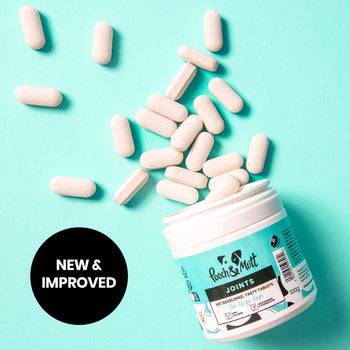
FREE UK DELIVERY ON ORDERS OVER £39.99
It’s a sad reality of being a dog parent that as your dog ages, their bones and joints wear down and they can’t get around as they once did. In fact, 65% of dogs over seven years old will develop arthritis, a progressive condition that attacks the cartilage in the joints and over time, can become debilitating for your poor pooch. So how can you support your dog in this tricky stage of life, ensuring they continue to live a day-to-day experience that keeps them as active, content and pain-free as can be?
Read on for our expert advice on helping a senior or arthritic dog with their joints and mobility, from using doggy wheelchairs to grip socks and supplements.

If your dog has started to get a bit wobbly on their feet, or perhaps has been diagnosed with arthritis by a vet, the first place you’ll want to ensure they feel comfortable is at home. After all, if your dog feels supported to tackle steps, varied flooring and ramps in a safe space, that inner confidence should translate into the outdoors when it’s time for walkies.
So, how to help a dog with arthritis? There are a number of ways you can help contribute to your arthritic dog’s mobility and wellbeing from day one:
Perhaps an obvious point to start off with, but if your pooch is showing signs of slowing down, i.e. they are slow to get up and reluctant to jump, go for walks or climb stairs, be sure to get them checked over by a vet as soon as possible. The vet will likely examine your dog, take some x-rays and may prescribe medication to ease your pooch’s aches and pains and help rebuild any lost muscle tissue. When it comes to arthritis symptoms especially, prescribed medication should be your first port of call.
While your home may have suited your younger, more nimble dog just fine, as their joints and bones get older you may need to make some adjustments. Slippery floors, for example, can add extra stress on your dog’s knees and ankles as they try to steady themselves, so consider laying down some anti-skid mats or strips of carpet so they can grip the floor more easily.
At mealtimes, if your pooch finds it hard to lower themselves to their food bowl, elevate the bowls so your dog can eat without straining. You can also install ramps where your dog is used to stepping or jumping, such as into the front door or up to your bed. See ‘Use dog mobility aids’ below for more on this.

Arthritis is more common in overweight dogs (1), so if your dog is on the heftier side (common as they get older), it’s important to keep them at a healthy weight to lessen the pressure on their joints. Time to stop feeding them scraps from the table or overdoing it on the treats, and instead invest in high-quality dog food made from all-natural ingredients - this way they’ll receive all the nutrients, vitamins and minerals they need for optimal physical and emotional health as they age.
Another way to keep the pounds at bay as well as boost your pooch’s overall sense of wellbeing; make frequent, gentle exercise a priority. Even if your dog is slower these days and can’t walk quite as far, you’ll be surprised at how much more sprightly they’ll become at a regular dose of fresh air.
Should you walk a dog with arthritis? Absolutely - but as your arthritic pooch will be slower and wear out more quickly, you should take them for short walks, more often.
Maintain regularity in these walks, even if you’re busy. Having your dog cooped up indoors all week only to take them for hours-long outings at the weekends will put unnecessary stress on their joints and likely exacerbate arthritis symptoms. Frequent, routine exercise is key to their physical and mental health at this stage of their life, so ensure you’re doing the best you can for them.
As a dog ages, the important ‘cartilage building’ substances that were present in their younger body start to deplete. Without this comfy cushioning, their knees, ankles, hips and other joints start to grind at the bone, causing them pain, swelling and decreased movement.
Help your dog with arthritis to replenish this vital cartilage by using joint and bone supplements for dogs. These can be easily included in your dog’s regular diet, but do check with your vet first.
Effective joint supplements for senior dogs will typically contain glucosamine and chondroitin (2), as well as natural ingredients proven to aid the repair of damaged cartilage in dogs (and humans), such as green-lipped mussel.
Glucosamine is a naturally occurring compound known to benefit dogs with arthritis or ageing joints, by slowing down cartilage degradation and boosting its repair. It’s particularly powerful when paired with chondroitin, as the two work together to help extend the life of your pooch’s joints and ease pain and swelling (3).
Other ingredients which could be present in joint and bone supplements for dogs include Type II collagen, selenium, calcium and fish oil - all of which are heroes of healthy bone and cartilage function.
Ready to accessorise? As well as kitting out your house with a few mobility aids, you can also try wearable accessories for dogs with arthritis to help them get around easier.
If your dog really hobbles and seems to be in a lot of pain as they walk, using a harness is a smart way to take some of the weight off their sore joints. The harness wraps around the bulk of your dog’s body so that you can lift them slightly as they walk, enabling them to move easier and still get valuable exercise, while using you as a support.
As mentioned, steps and jumps can become a nightmare for some dogs as they age, so a few well-placed ramps can be life-changing. A gentle slope leading into the door, bed or car, for example, can ensure your dog needn’t limit their daily adventuring or have to drop their usual routines while getting around your home. Give them the means to function normally and they’ll walk with an added spring in their step as a thank you.
As a dog owner, you sadly can’t be in control of every flat surface your dog ambles along. To give them extra grip wherever they wander, why not try a pair of mobility socks for dogs? Used mostly by elderly dogs or severely arthritic dogs, they wrap around your dog’s paws to increase grip, so your dog can confidently pace across most surfaces without struggling, stumbling or falling. In a range of neon colours, they look very snazzy, too. Just be sure to check with your vet for suitability, as in some breeds, socks can affect a dog’s gait and actually worsen symptoms of joint pain.
In extreme cases where your poor pooch’s knees, ankles or hip joints have all but given out, wheelchairs for arthritic or ageing dogs can be a great, last resort solution. No matter how much their mobility has deteriorated, all dogs benefit from a bit of exercise, a change of scenery and time outdoors. Continuing to take them out for a short, regular walk - even if they’re on wheels - will maintain their emotional health into the late stages of arthritis and old age, so that even if their body is old, their demeanour will stay happy and care-free.
If your dog is senior or has arthritis, or you just want to delay the bone and joint degradation in dogs that comes with age, check out our range of natural joint care and mobility supplements for dogs. Get in touch with us if you have any other questions about bone and joint care for dogs.
References
Comments (4)
Is it a good idea to give my dog codliver oil for arthritis she has pain in her joints wat natural remedies can i give her
Hi Beverley please email us Poochpoochandmutt.com and we can give you some advice on this.
My dog is twelve and a half and slowing down is there a supplement I am give him
Hi Rosalind, it might be worth taking a look at our Joint Supplement tablets, which come in 2 different sizes. They contain Glucosamine and Chondroitin Sulphate to prevent cartilage breakdown, Hyaluronic Acid to aid joint lubrication to reduce friction and pain, with added Vitamin C to contribute its antioxidant properties. These supplements also contain extra additions (where competitors don’t) with proven joint health benefits; including MSM (Methylsulphonylmethane) – an anti-inflammatory that offers effective pain relief and Collagen, which provides structural support. If you have any questions on this, please do reach out to the team on [email protected] :)
Leave a comment